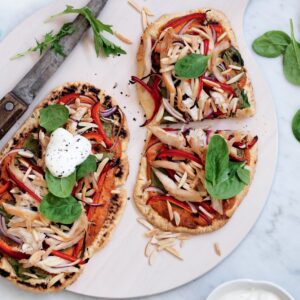
Ageing is a fact of life but there are things you can do to slow it down. As dietitian Brooke Longfield explains, it starts with what you eat.
It’s the little things we notice that make us feel like we’re getting older: the laugh lines around our eyes, our gradual loss of flexibility or the dry skin on our elbows and heels. Perhaps it’s also the sore knee or stiff back.
But, instead of combating ageing from the outside with expensive cosmetics and anti-wrinkle creams, it’s actually cheaper and more effective to tackle it from the inside out.
After all, what you eat is one of the best predictors of how well you age. One recent study found eating at least five portions of fruit and vegetables every day can add three years to your life. New research also shows what we eat in our 20s can impact our physical age in our 40s and 50s. And at each age in turn, the food choices we make have a long-term effect on how we’re going to feel today, tomorrow and in 10 years.
Whatever age you are now, here are some food investments to benefit and even slow your ageing.
Feeling stiff in the joints?
Stiffness and pain in our wrists, finger joints and hips is one of the earliest signs of arthritis. This inflammatory condition interferes with even basic daily tasks, such as cooking, driving and walking.
Pain in our knees can be caused by being overweight, which puts extra stress on our joints. This wear and tear can make us less inclined to exercise, as the pain interferes with mobility. But keeping active can be key to weight loss and, in turn, this helps ease joint pain.
Carrying extra weight also increases your risk of heart disease and diabetes.
Fight back: Oily fish
Omega-3 fats in oily fish, such as salmon, tuna and sardines, fight inflammation in stiff joints. Aim to include oily fish in your diet 2–3 times a week, and consider a fish oil supplement on top of this if you suffer from arthritis.
How’s dem bones?
Strong bones are vital for preventing fractures and osteoporosis. The density of our bones starts to decrease from 35–40 years, and it occurs much faster in women.
If your body isn’t getting enough calcium from dairy foods, such as milk, cheese and yoghurt, it takes what it needs from your bones. This makes the bones weak, brittle and at risk of fractures.
We’re advised to consume at least two serves of mostly low and reduced-fat milk and milk products each day. Many people unnecessarily avoid milk and dairy foods in favour of dairy-free alternatives, such as almond milk and coconut milk, which are often not fortified with calcium.
Fight back: Dairy foods
The key ingredient for strong bones is calcium-rich food. Milk, yoghurt and cheese have the most calcium of all foods and it’s the most bioavailable, meaning we can use more of the calcium in milk and milk products than we can from other foods. Make it easy to get your daily needs by pouring milk over your cereal in the morning, adding two slices of cheese to your sandwich or salad and snacking on a small tub of plain yoghurt.
Choose unsweetened milk and yoghurt, and opt for reduced-fat dairy where possible. If you can’t tolerate cow’s milk, make sure your milk alternative (such as soy milk) has been calcium fortified.
Any memory loss?
Forgetting where you put your keys may not necessarily be a sign that you’re getting old. For many of us, memory loss is largely due to the brain not getting enough of certain vitamins and minerals. A 2015 study found people who eat more high-fat and high-sugar processed food, such as soft drinks and salty snacks, have a smaller hippocampus, the part of the brain that’s critical for learning and memory.
The type of fat you eat is also important. Studies link a diet high in saturated fats, found in butter and processed meats, such as sausages, bacon and salami, to poor results in thinking and memory tests. Conversely, eating plenty of healthy unsaturated fats, such as those found in salmon, nuts and avocado, has been shown to reduce the risk of developing dementia by half.
Fight back: Nuts
Many nuts are rich in omega-3 fats, which play an important role in keeping your brain healthy. Many also contain vitamin E, an antioxidant that may reduce the likelihood of memory loss. Walnuts are especially beneficial, with a 2014 US study showing just a handful a day can help improve cognitive function.
Fight back: Eggs
Packed with protein, eggs also contain vitamin D, B12, selenium and choline. Perhaps not as familiar as the other nutrients, choline has been shown to help memory and mental alertness. While eggs got a bad rap in past decades, the Heart Foundation tells us, for most people, up to seven eggs a week can be included as part of a heart-healthy eating pattern.
Are your eyes looking good?
While many of us find it harder to see things up close as we get older, it isn’t the only age-related eye problem. Macular degeneration is the loss of central vision and makes it difficult for a person to see fine detail or even read this page.
It affects one in seven Kiwis over the age of 50. Research shows that heavy smoking and a diet high in trans fats (think packet biscuits and pastries) can increase your risk of developing this disorder, which is the leading cause of blindness.
For people who have diabetes, the right food choices can minimise the risk of developing eye complications such as glaucoma and cataracts.
Fight back: Dark green, leafy vegetables
Baby spinach, kale and silver beet are rich in lutein and zeaxanthin, which are vital for eye health. They’re also found in peas, Brussels sprouts and sweetcorn.
Taking care of your skin?
As we age, the fat and collagen directly under our skin diminishes, so there is less padding, especially in our face. This means our skin has less support, leading to wrinkles.
If you are a smoker, spend lots of time in the sun or regularly drink more than two standard drinks of alcohol in a day, you’ll notice the wrinkles even sooner.
What we eat can also affect our skin. The chemicals released from certain foods can age us from the inside out. These chemicals are aptly called AGEs (advanced glycation end products) and research suggests they speed up the loss of collagen in our skin. Foods high in AGEs include charred meat and fried foods, such as hot chips.
Dehydration can cause our skin to look dry and wrinkled, as water plays a key role in maintaining elasticity and suppleness. Aim to drink 8–10 glasses of water each day, and remember that alcohol, and excessive tea and coffee, can act as diuretics that can dehydrate your skin.
Fight back: Vitamin C-rich fruit and veg
Vitamin C is essential for making collagen, which gives skin its strength and flexibility. Vitamin C also reduces the harmful effects of sun and smoke on your skin. So fill your plate with fruit and vegetables that are rich in vitamin C, such as citrus fruits, red capsicum, broccoli, strawberries and kiwifruit. All fruit and veges help defend against AGEs, so eat plenty of them each day.
Consume these foods and drinks to help fight ageing
It’s not just one food that holds the key to youthfulness: it’s a combination of these foods that help slow premature ageing.
- Salmon: Rich in omega-3 fats for healthy joints and memory, as well as eye health
- Avocado: Has a combination of vitamins C and E and ‘good’ fats for skin, eyes and your heart
- Berries: High in vitamin C and antioxidants for supple skin
- Milk: A great source of calcium for strong bones
- Green tea: High in antioxidants to protect from cancer and heart disease
- Nuts: Provide heart-healthy fats and selenium for healthy skin
- Eggs: Contains choline for brain health and vitamin A for eye health
- Spinach: Full of protective antioxidants to fight age-related disease
- Water: Maintains elasticity and suppleness of skin.
- Extra-virgin olive oil: Contains heart-friendly fats and powerful antioxidants
- Tomatoes: Cooked, canned and processed tomatoes, such as tomato paste, are especially rich in lycopene, an antioxidant associated with reduced risk for prostate cancer and heart disease.
Antioxidants = anti-ageing
While supplements offer concentrated amounts of some antioxidants, research tells us the combination of antioxidants found in real foods benefits our long-term health the most. Powerful antioxidants are found in colourful foods. Here are five easy ways to eat more antioxidants:
1. Snack on raw veg
Raw veges are great for snacking and have more antioxidant vitamin C than cooked ones, as some is lost through cooking. Mix it up though – other antioxidants are more available when cooked.
2. Cook with spice
We may only use small amounts, but herbs and spices are extremely high in antioxidants, so they’re a healthy way to add flavour to meals. Levels in turmeric, chilli and cinnamon are especially high, so use these on a regular basis.
3. Eat the rainbow
The brighter the fruit or veg, the richer it is in antioxidants. Have three colours on your plate each night – eg, orange kumara, broccoli and red capsicum.
4. Sip smarter
Black tea is rich in antioxidants, but green tea has even more. Drink at least three cups a day and reap the benefits.
5. Leave the skin on
There are lots of antioxidants located close to the skin of fruit and veges. So, don’t peel it off, eat it!
Article sources and references
- Arab et al. 2014. A cross sectional study of the association between walnut consumption and cognitive function among adult US populations represented in NHANES. Journal of Nutrition, Health and Aging 19:284https://www.ncbi.nlm.nih.gov/pubmed/25732213
- Agarwal S & Rao AV. 2000. Tomato lycopene and its role in human health and chronic diseases. Canadian Medical Association Journal 163:739-44https://www.ncbi.nlm.nih.gov/pubmed/11022591
- Arthritis Australia. 2015. Fish Oils, arthritisaustralia.com.au Accessed June 2016https://arthritisaustralia.com.au/managing-arthritis/living-with-arthritis/complementary-treatments-and-therapies/fish-oils/
- Arthritis Australia. 2015. What is Arthritis? arthritisaustralia.com.au Accessed June 2016https://arthritisaustralia.com.au/
- Arthritis Australia. 2016. How Fat Affects Arthritis, arthritisaustralia. com.au Accessed June 2016https://arthritisaustralia.com.au/
- Australian Bureau of Statistics. 2016. Australian Health Survey: Consumption of Food Groups from the Australian Dietary Guidelines, 2011-12, abs. gov.au Accessed June 2016https://www.abs.gov.au/ausstats/[email protected]/Lookup/4364.0.55.012main+features12011-12
- Bellavia et al. 2013. Fruit and vegetables consumption and all-cause mortality: a dose-response analysis. American Journal of Clinical Nutrition 98:454-9https://www.ncbi.nlm.nih.gov/pubmed/23803880
- Better Health Channel. 2014. Age-related macular degeneration, betterhealth.vic.gov.au Accessed June 2016https://www.betterhealth.vic.gov.au/health/ConditionsAndTreatments/age-related-macular-degeneration?viewAsPdf=true
- Chong et al. 2009. Fat consumption and its association with age-related macular degeneration. Archives of Ophthalmology 127:674-80https://www.ncbi.nlm.nih.gov/pubmed/19433719
- Cosgrove et al. 2008. Dietary nutrient intakes and skin-aging appearance among middle-aged American women. American Journal of Clinical Nutrition 86:1225-3https://www.ncbi.nlm.nih.gov/pubmed/17921406
- European Food Information Council. 2016. Mediterranean style diet might slow down aging, reduce bone loss. ScienceDaily, 3 May 2016https://www.sciencedaily.com/releases/2016/05/160503072603.htm
- Harvard Health Publications. 2012. Boost your Memory by Eating Right, health.harvard.edu Accessed June 201https://www.health.harvard.edu/mind-and-mood/boost-your-memory-by-eating-right
- Jacka et al. 2015. Western diet is associated with a smaller hippocampus: a longitudinal investigation. BMC Medicine 13:215https://bmcmedicine.biomedcentral.com/articles/10.1186/s12916-015-0461-x
- Macular Disease Foundation Australia. 2012. Macular Degeneration: Facts and figures, mdfoundation. com.au Accessed June 2016https://www.mdfoundation.com.au/content/annual-reports
- Macular Disease Foundation Australia. 2013. Nutrition & supplements for macular degeneration. mdfoundation.com.au Accessed June 2016https://www.mdfoundation.com.au/
- University of Maryland Medical Center. 2012. Skin wrinkles and blemishes, umm.edu Accessed June 2016https://www.umms.org/ummc
www.healthyfood.com










